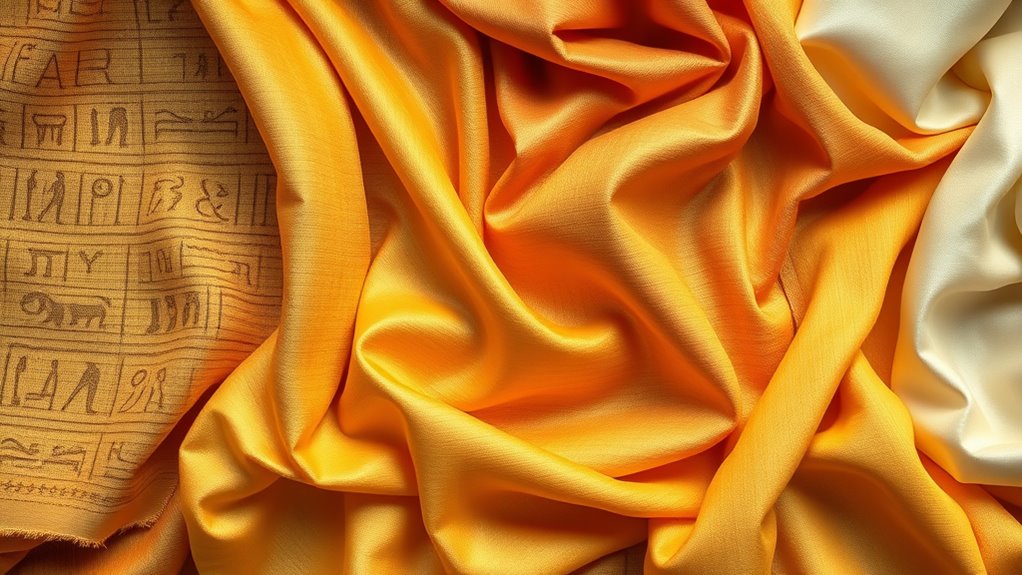Fabrics have shaped civilizations by fueling trade, expressing cultural identities, and inspiring technological advances. Early dyeing methods using plant extracts created vibrant textiles that symbolized power and connected distant regions. The invention of spinning wheels, mechanized looms, and synthetic dyes expanded production and durability. These innovations drove economic growth and cultural exchange through routes like the Silk Road. Continue exploring, and you’ll discover how textiles have left a lasting impact on societies worldwide.
Key Takeaways
- Early plant-based dyes in Egypt, China, and India created vibrant textiles that symbolized power and cultural identity.
- The invention of spinning and weaving technologies expanded textile production and intricate cultural storytelling.
- Synthetic dyes in the 19th century revolutionized textile colors, boosting trade and cultural exchange.
- Textiles along trade routes like the Silk Road fostered diplomatic relations and economic growth across civilizations.
- Modern innovations blend traditional methods with eco-friendly and smart fabrics, continuing the cultural legacy of textiles.

The textile industry has a rich history that reflects human innovation and cultural exchange over thousands of years. You might not realize it, but the fabrics you wear today are the result of centuries of experimentation, discovery, and adaptation. One of the earliest and most significant developments was the creation of dyed fabrics. When humans first learned to add color to textiles, it transformed the way societies expressed identity, status, and artistry. Early dyeing techniques, such as using plant extracts, allowed civilizations in Egypt, China, and India to craft vibrant, long-lasting textiles that became symbols of power and cultural heritage. These dyed fabrics played a *vital* role in trade, diplomacy, and social hierarchy, connecting distant regions through the exchange of colorful, beautifully crafted textiles.
Dyed fabrics revolutionized trade, culture, and identity in ancient civilizations like Egypt, China, and India.
As you explore the evolution of textiles, you’ll see how textile innovations continually pushed boundaries. From simple hand-spun fibers to complex woven textiles, each breakthrough opened new possibilities. The invention of the spinning wheel and later mechanized looms increased production speed and quality, making textiles more accessible to broader populations. These innovations not only improved efficiency but also allowed for intricate patterns and designs that reflected cultural stories and beliefs. The development of dyeing techniques, such as the creation of synthetic dyes in the 19th century, further revolutionized the industry. Suddenly, textiles could boast brighter, more diverse colors that resisted fading, enabling textiles to serve as both functional clothing and artistic expression. Additionally, color fastness improvements ensured that textiles maintained their vibrancy over time, enhancing their value and durability.
Throughout history, textile innovations have also driven economic and social change. As techniques for dyeing and fabric production advanced, textiles became valuable commodities in international trade. The Silk Road, for example, facilitated the exchange of luxurious silk and other dyed fabrics between East and West, influencing fashion, craftsmanship, and even diplomatic relations. You can see how these innovations not only improved textile quality but also helped shape civilizations by fostering cultural exchange and economic growth. The ability to produce and replicate dyed fabrics efficiently meant that textiles became more than mere clothing; they became symbols of cultural identity, social status, and technological progress.
Today, modern textile innovations continue to build on this rich history, blending traditional methods with cutting-edge technology. From eco-friendly dyes to smart fabrics embedded with sensors, the legacy of dyed fabrics and textile advances persists. They remind us that textiles are more than just material—they reflect human ingenuity, cultural storytelling, and the ongoing quest to improve how we create, communicate, and connect across civilizations.
Frequently Asked Questions
How Did Textiles Influence Ancient Trade Routes?
You see, textiles played a vital role in shaping ancient trade routes by fueling trade networks that connected different civilizations. As you trade fabrics like silk and cotton, you facilitate cultural exchange, sharing ideas, techniques, and traditions. These trade routes become vibrant pathways for commerce and cultural interaction, making textiles more than just goods—they’re symbols of connection, influence, and the spread of civilizations across regions.
What Are the Earliest Known Textile Techniques?
You’re curious about the earliest textile techniques. You learn that ancient dyeing methods, like using natural plant and mineral dyes, date back thousands of years, giving fabrics vibrant colors. Weaving innovations, including simple loom setups, allowed early humans to create cloth more efficiently. These techniques laid the foundation for advanced textile practices and helped civilizations develop complex trade networks, showcasing the importance of early dyeing and weaving in human history.
How Did Textile Production Impact Societal Hierarchies?
You see, textile production influenced societal hierarchies by reinforcing social stratification and showcasing status through textile symbolism. Wealthier classes often owned finer fabrics and intricate designs, signaling their power. As a result, textiles became a visual marker of social rank, creating distinctions within communities. This cultural significance cemented social roles, making textiles more than just clothing—they became symbols of identity, privilege, and societal division.
What Role Did Textiles Play in Religious Rituals?
You see, textiles played a crucial role in religious rituals by creating sacred textiles and ritual garments. These fabrics often held spiritual significance, symbolizing divine presence and purity. When you wear or see these sacred textiles, they connect you to tradition and faith, emphasizing their importance in ceremonies. Ritual garments made from special fabrics help distinguish participants and elevate the spiritual experience, highlighting textiles’ deep influence on religious practices.
How Are Modern Fabrics Evolving From Historical Materials?
You might think fabrics today are entirely new, but they’re really just evolving from history’s textiles. Thanks to sustainable innovations and technological advancements, modern fabrics now blend eco-friendly materials with smarter designs. It’s ironic how we chase futuristic fabrics while building on centuries of textile craftsmanship. So, in a way, today’s textiles are a clever remix of the past, pushing boundaries while honoring centuries of fabric evolution.
Conclusion
As you’ve seen, textiles have woven their way through history, shaping civilizations more than any other invention. From simple fibers to luxurious fabrics, they’ve fueled trade, culture, and innovation. Imagine a world without textiles—it’s like a universe without stars, lacking color and life. So next time you wear your favorite shirt, remember, you’re part of a timeless story that’s transformed societies and spun the fabric of human progress itself.







